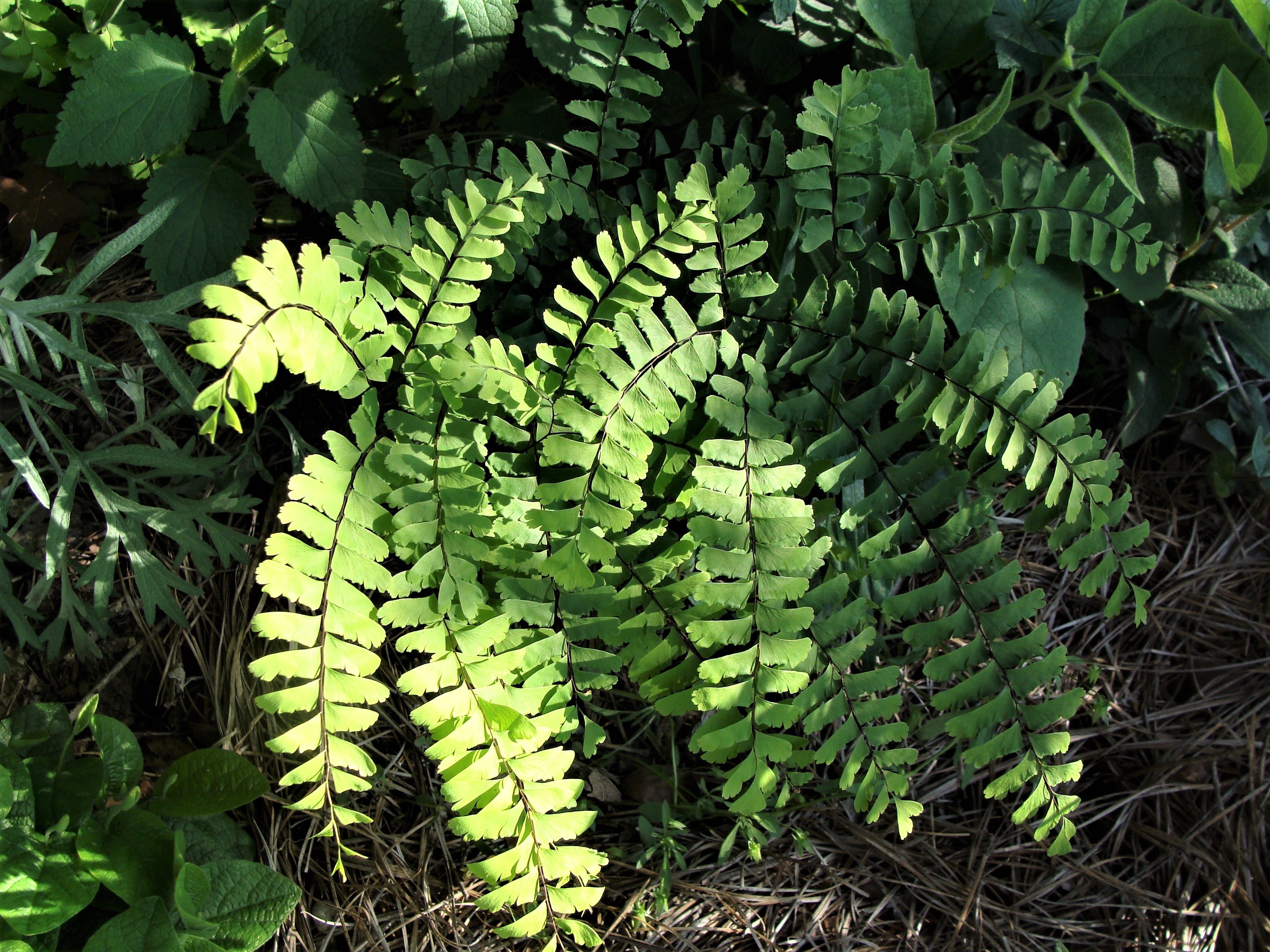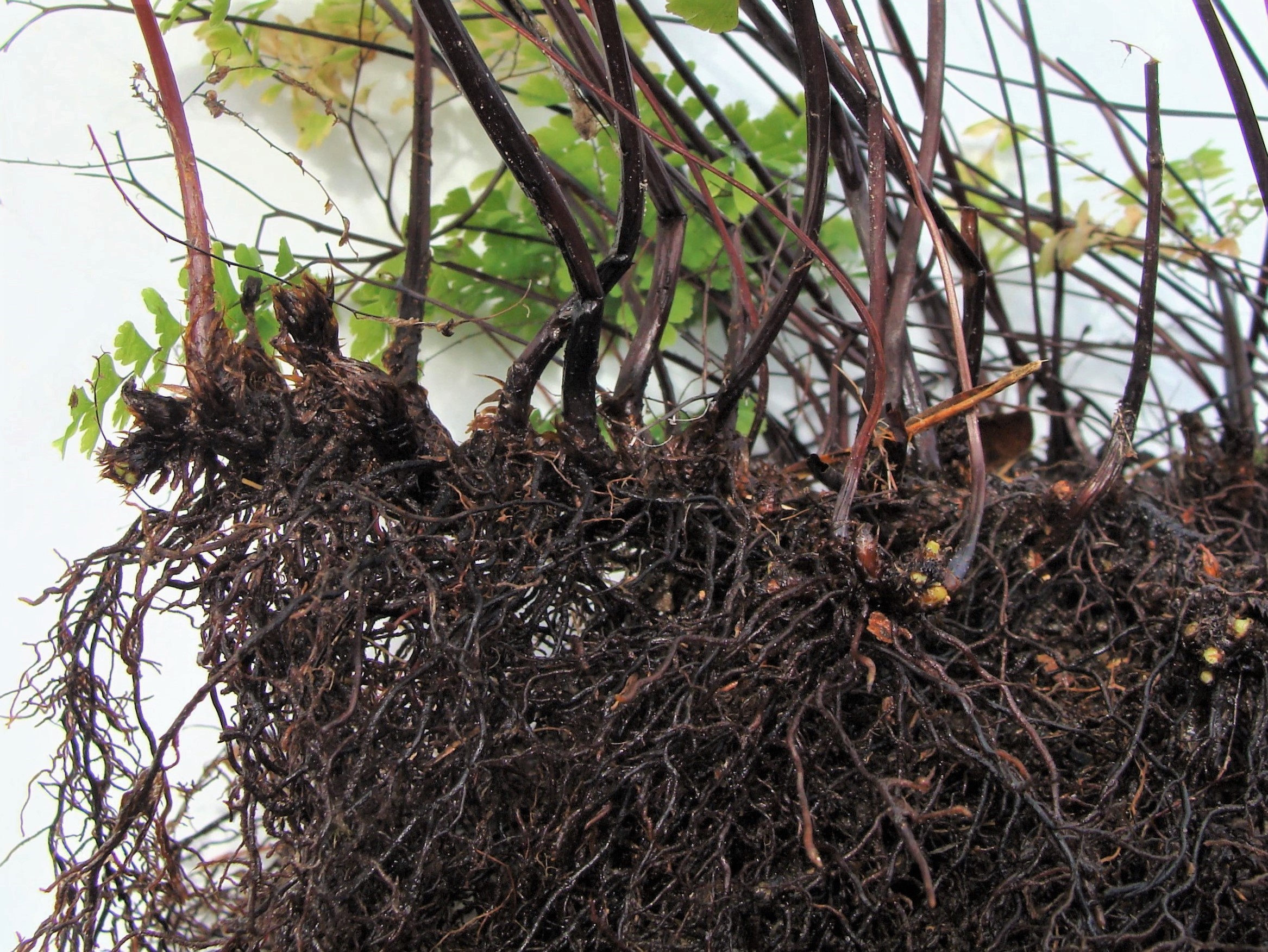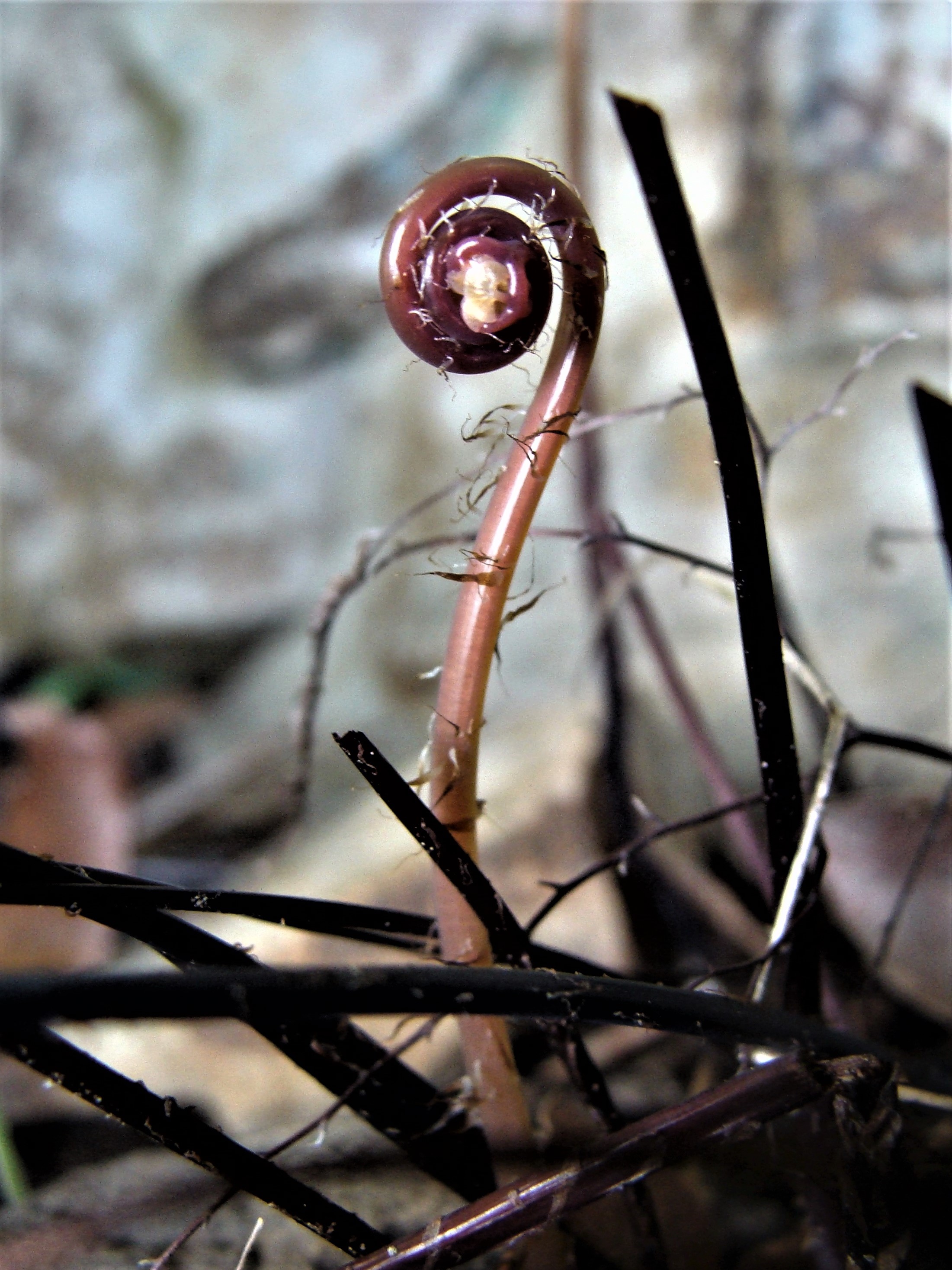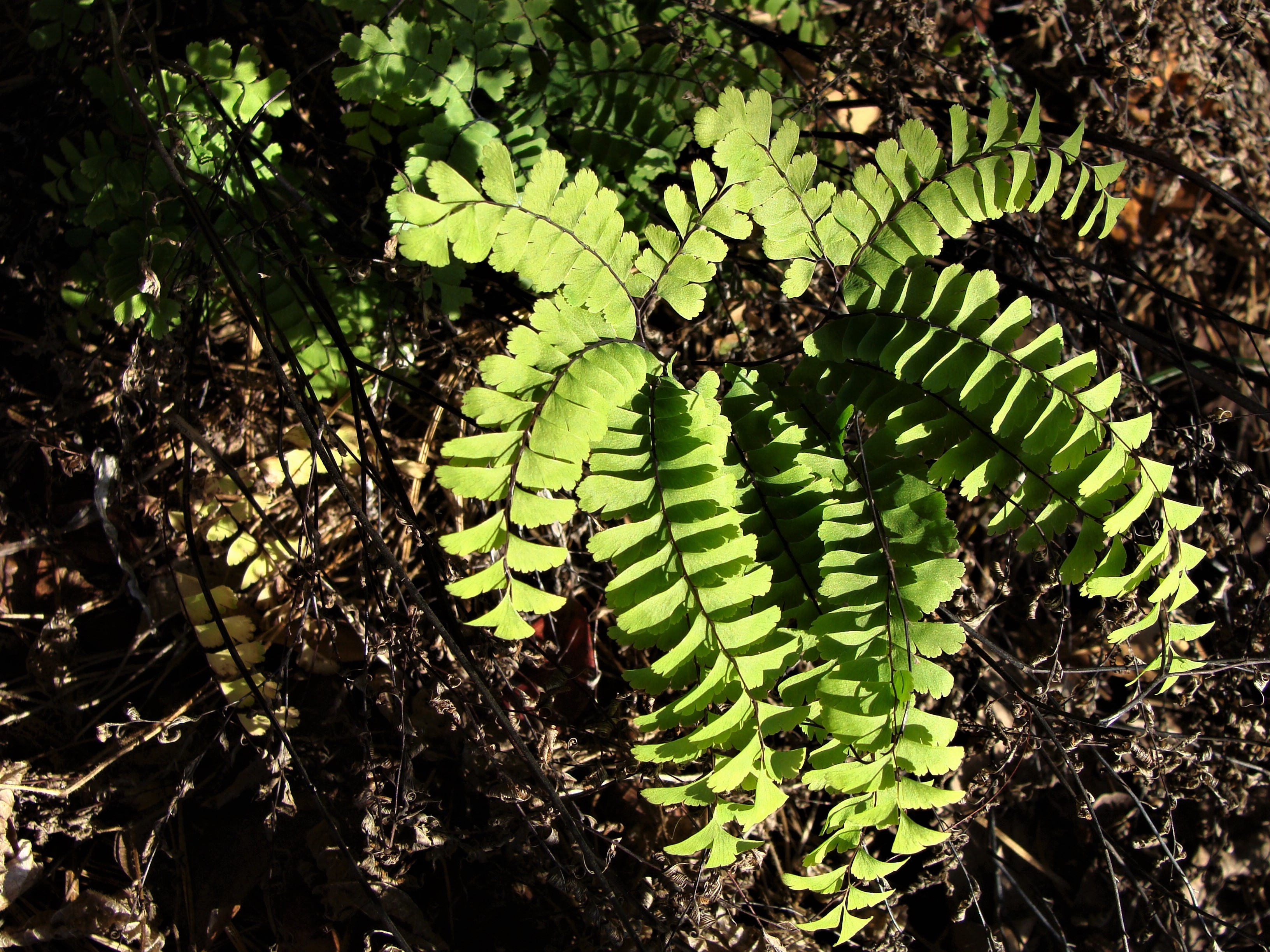Northern Maidenhair Fern (Adiantum pedatum) of the Brake Fern (Pteridaceae) family, formerly of the Polypody (Polypodiaceae) family, is a beautiful, shade-loving fern with broad, circular fronds. The genus name is from a Greek word for “unwetted” in reference to the leaves’ ability to shed raindrops. The specific epithet refers to the foot-like shape of the larger pinnules (secondary leaflets). In the U.S., the species is of common occurrence across the eastern half of the country from the Canadian border southward, absent only from Florida and rare in much of the Atlantic and Gulf Coastal Plains. In Arkansas, it occurs across most of the state except for the Mississippi Alluvial and West Gulf Coastal Plains. Favored habitats are rich, deciduous woodlands with well-drained soils.

Northern Maidenhair, like most Temperate Zone ferns, is deciduous and perennial. Leaves arise from shallow, short-branched, dark brown rhizomes ¼+ inch in diameter––these mostly concealed by a dense tangle of dark brown, wiry roots. In April, pink to reddish fronds (leaves) emerge as coiled “fiddleheads.” Fiddlehead stipes (stalks) are reddish brown, lustrous, and smooth, with scattered, long, light brown, translucent scales. As fronds mature, stipes and rachises become black. Spiky old stipes persist for a year or more. Colonies are slow growing.


Mature fronds vary considerably in size, depending on habitat, with a large frond being 2 feet long (including a 15-inch stipe) and a foot wide. The erect stipes divide into a pair of curved, widely divergent rachises that bear 4-6 pinnate pinnae (the primary leaflets), along their convex side. Proximal pinnae may be 8 inches long, gradually shortening to 2 inches distally. Viewed from above, fronds have an attractive, circular shape. Larger ferns may grow to a height of 1½ feet. Fronds are glabrous, except for scales along the lower portion of the stipes.


The green, photosynthetic unit of Northern Maidenhair Fern is the pinnule, the secondary leaflet. Up to about 20 pinnules are borne on a pinna. Larger pinnules have an inverted-wing shape––the lower margins are entire (uncut) and curved upward while the upper margins are lobed. Pinnules are to ¾+ inch long and ⅜ inch wide, widest near the base. Smaller pinnules, at both ends of the pinna, are stubby to rounded. Solitary pinnules occur on the rachis a short distance below the pinna (see Photo 4). These may be ¼+ inch long and ½+ inch wide with a cuneate base and a fanned apex that is variously divided. Pinnules have thin, wiry, ⅛-inch-long stalks. With winter-kill, light tan crumpled pinnules are retained on the rachis for several months while stipes persist for a year or two.

Pinnule venation (see photo 9) is of uniform size and character. In wing-shaped pinnules, a single vein originates at the stalk and, extending along the uncut, lower (proximal) margin, gives rise to further veins that extend, typically forking, into the lobe tips and sori of the upper margin. With solitary fan-shaped pinnules, all veins radiate from the stalk.
Northern Maidenhair Fern has separate fertile and sterile fronds, both with a very similar upper surface. On the lower surface of the fertile fronds, the upper (distal) margin of the pinnules bears 1-8 small, pocket-like clusters of sporangia called sori (singular, sorus). Sori are covered and protected by a narrow strip of the pinnule margin (called a false indusium) that folds back over the sporangia. Indusia are initially pale yellow-green, darkening as sori mature. With sorus maturity in September, indusia dry and loosen, allowing sporangia to discharge minute spores into the air, to be dispersed on breezes.



With dispersal of spores, the reproductive activity of the “sporophyte” phase of a fern’s life cycle concludes. In the soil, spores germinate to produce a tiny plant called a prothallus, the “gametophyte” phase. The prothallus, which looks more like an alga than a fern, produces gametes: sperm and egg. Sperm swim through ground moisture to fertilize eggs that remain attached to the prothallus. Fertilization produces a zygote that, in turn, develops into a new sporophyte plant––the plant we recognize as a “fern.”
Northern Maidenhair Fern is a lovely, graceful fern for a shaded mesic site in a naturalistic garden, woodland garden, or even a rock garden. It is suitable for mass-planting or as a specimen plant. It mixes well with other plants of modest height with similar habitat requirements or tolerance. It is slow to spread. Dead fronds provide winter interest with their shiny black wiry stalks and dangling light tan leaves. By spring, except for the stipes, fronds have disintegrated so that springtime clean-up may not be needed.

An additional species of Adiantum occurs in Arkansas, Southern Maidenhair Fern (A. capillus-veneris). Southern Maidenhair Fern (aka Venus’ Hair Fern) can be distinguished by: 1) preferred habitat being wet vertical cliffs and rock faces but can even establish on masonry walls with lime mortar, 2) stipe undivided, 3) pinnae occurring on both sides of rachises, and 4) pinnules fan-shaped and pendant.
Article and photographs by ANPS member Sid Vogelpohl

